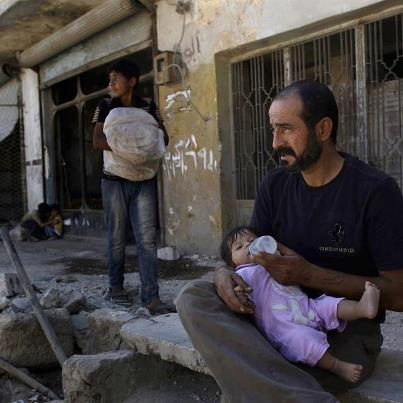The images of murdered men, women, and children broadcast in snippets by Arab and world satellite stations from the battlefields of the Syrian revolution have become almost like a live “exhibition,” with images rolling in day after day uninterrupted... It is as if the charred and dismembered remains of human bodies are all identical, regardless of the region or neighborhood. The corpses, particularly those of women and children, cannot be “re-made,” “rectified,” “adjusted,” or edited. They are bodies of children killed in Aleppo, Homs, Al Rastan...the place is not important. The bodies themselves have become “the place” and the place has become, for its part, a metaphorical realm, because the abundance of killings and mutilations has emancipated it from reality. If the spectator is distracted for a moment, he might imagine that what he watched was a scene from a massacre that took place in Gaza, or in Lebanon’s Qana as the result of brutal Israeli bombardment. The executioners are one and the same, just as the dead do not differ from each other; for violence is one whether it is perpetrated by us or the Israelis… and so is bloodshed, killing, and destruction.
These primitively and amateurishly filmed “scenes” may trouble many viewers to the point that they are no longer able to watch them on television. How many voices were raised, calling for the deletion of these cruel and inhuman scenes from news programs and investigative reporting? They are truly painful scenes, confronting the viewer with a surreal landscape, a nightmarish reality that cannot be accommodated or rationalized no matter how often they are repeated and how identical they appear.
The spectator cannot avert his eyes from these scenes. He might avert them for a moment, but his gaze will most likely fixate on the obscene spectacle of children slaughtered, stabbed, mutilated, or discarded like worn-out toys, smeared with their own blood, eyes open to the heavens, hands pointing in the opposite direction. The spectator feels that he is seeing himself killed here, his body strewn amidst these corpses. He feels pain for these children as he would feel pain for himself. He is afraid and disturbed. He trembles… entitled to these emotions.
The images impose their ritualism in this open exhibition, but there is no “worship” here, or supplication. Rather, the self withdraws into its wounds, apprehensions, and turbidity. While those women and children are kin to saints and angels, they are also made from blood’s sap. The blood burns and wounds… the violence visited upon them by the “butchers” has almost overwhelmed the angelic nature and purity that inhabits their eyes and emanates from their delicate bodies. Violence does not only kill the body, but the spirit, too. Those innocent victims are not strong enough to face the killing machine, the hellish machine that shows no mercy.
But for pictures like these, painful and terrifying, there would be no revolution; the revolution would not have triumphed or reached its purpose. Revolution needs the constant power of images in order to realize itself and its goals. It is images that “beautify” the revolution with its tragedy, that give the revolution its true meaning, that reveal its symbolism and move it from a metaphorical state to a realistic one, from an existence in thought to one of flesh and blood. These images assure that the impossible is possible and that the possible is merely a form of pain and agony. We have become controlled by images that are always ahead of us, that mock us, that scandalize us, that prostrate us and lay us bare.
When I see on television images of the murders committed by the Syrian regime, I imagine that I hear the murdered women and children; I hear their final screams; I hear their heartbeats and the closing of their sad eyes; I hear the echo of their soft fall to the earth. It seems to me, whenever I have seen their corpses — pardon me, their bodies — that I hear their images; I hear them in my ears as well as with my eyes. My senses become confused from the intensity of terror. Do I truly see what I see? Or do I need to hear and touch…so that I comprehend what I see?
We cannot — or I cannot — get accustomed to these pictures that our screens bring us morning and evening; these pictures are not repetitive, no matter how much they resemble each other. They create themselves continually from amidst the ashes they leave behind them, from the ashes that are the earth, the earth of life lost by women and children, so that others may live this life. Others that are them and us and you…
Translated from the Arabic by Lauren Khater.
The Arabic version of this article appeared in Al Hayat, July 16 2012.
This article appeared in Al Jadid Magazine, Vol. 17, No. 64, 2011.
Copyright © 2011 AL JADID MAGAZINE

